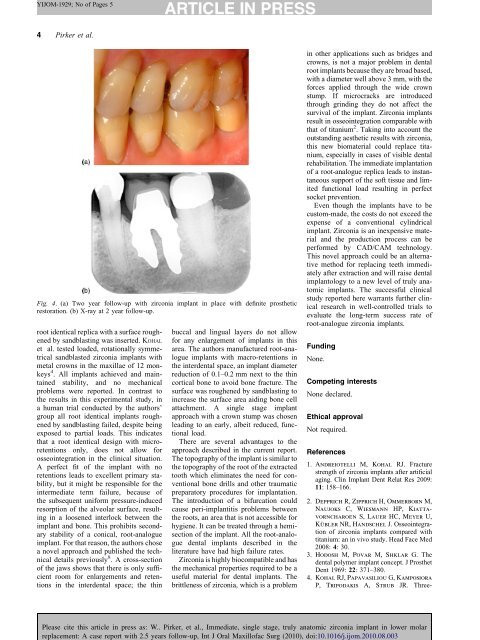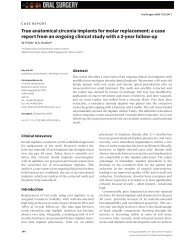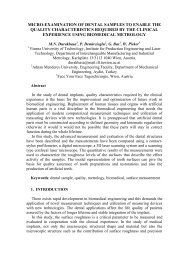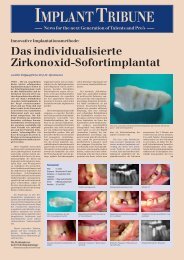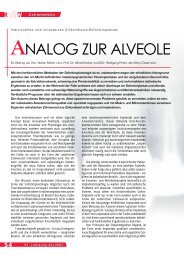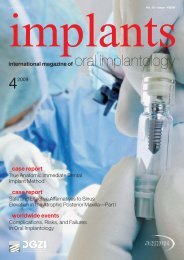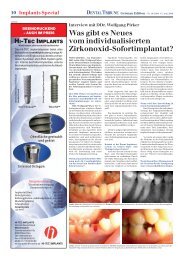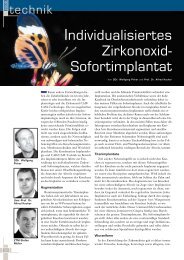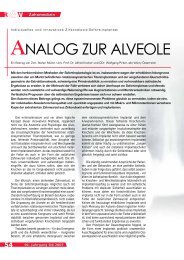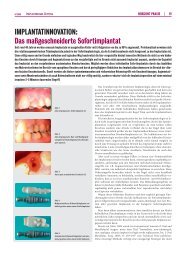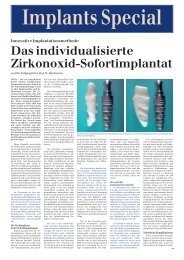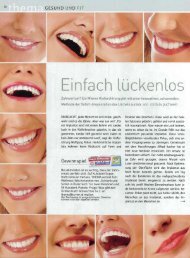A case report with 2.5 years follow-up
Create successful ePaper yourself
Turn your PDF publications into a flip-book with our unique Google optimized e-Paper software.
YIJOM-1929; No of Pages 5<br />
Please cite this article in press as: W.. Pirker, et al., Immediate, single stage, truly anatomic zirconia implant in lower molar<br />
replacement: A <strong>case</strong> <strong>report</strong> <strong>with</strong> <strong>2.5</strong> <strong>years</strong> <strong>follow</strong>-<strong>up</strong>, Int J Oral Maxillofac Surg (2010), doi:10.1016/j.ijom.2010.08.003<br />
4 Pirker et al.<br />
Fig. 4. (a) Two year <strong>follow</strong>-<strong>up</strong> <strong>with</strong> zirconia implant in place <strong>with</strong> definite prosthetic<br />
restoration. (b) X-ray at 2 year <strong>follow</strong>-<strong>up</strong>.<br />
root identical replica <strong>with</strong> a surface roughened<br />
by sandblasting was inserted. KOHAL<br />
et al. tested loaded, rotationally symmetrical<br />
sandblasted zirconia implants <strong>with</strong><br />
metal crowns in the maxillae of 12 monkeys<br />
4 . All implants achieved and maintained<br />
stability, and no mechanical<br />
problems were <strong>report</strong>ed. In contrast to<br />
the results in this experimental study, in<br />
a human trial conducted by the authors’<br />
gro<strong>up</strong> all root identical implants roughened<br />
by sandblasting failed, despite being<br />
exposed to partial loads. This indicates<br />
that a root identical design <strong>with</strong> microretentions<br />
only, does not allow for<br />
osseointegration in the clinical situation.<br />
A perfect fit of the implant <strong>with</strong> no<br />
retentions leads to excellent primary stability,<br />
but it might be responsible for the<br />
intermediate term failure, because of<br />
the subsequent uniform pressure-induced<br />
resorption of the alveolar surface, resulting<br />
in a loosened interlock between the<br />
implant and bone. This prohibits secondary<br />
stability of a conical, root-analogue<br />
implant. For that reason, the authors chose<br />
a novel approach and published the technical<br />
details previously 8 . A cross-section<br />
of the jaws shows that there is only sufficient<br />
room for enlargements and retentions<br />
in the interdental space; the thin<br />
buccal and lingual layers do not allow<br />
for any enlargement of implants in this<br />
area. The authors manufactured root-analogue<br />
implants <strong>with</strong> macro-retentions in<br />
the interdental space, an implant diameter<br />
reduction of 0.1–0.2 mm next to the thin<br />
cortical bone to avoid bone fracture. The<br />
surface was roughened by sandblasting to<br />
increase the surface area aiding bone cell<br />
attachment. A single stage implant<br />
approach <strong>with</strong> a crown stump was chosen<br />
leading to an early, albeit reduced, functional<br />
load.<br />
There are several advantages to the<br />
approach described in the current <strong>report</strong>.<br />
The topography of the implant is similar to<br />
the topography of the root of the extracted<br />
tooth which eliminates the need for conventional<br />
bone drills and other traumatic<br />
preparatory procedures for implantation.<br />
The introduction of a bifurcation could<br />
cause peri-implantitis problems between<br />
the roots, an area that is not accessible for<br />
hygiene. It can be treated through a hemisection<br />
of the implant. All the root-analogue<br />
dental implants described in the<br />
literature have had high failure rates.<br />
Zirconia is highly biocompatible and has<br />
the mechanical properties required to be a<br />
useful material for dental implants. The<br />
brittleness of zirconia, which is a problem<br />
in other applications such as bridges and<br />
crowns, is not a major problem in dental<br />
root implants because they are broad based,<br />
<strong>with</strong> a diameter well above 3 mm, <strong>with</strong> the<br />
forces applied through the wide crown<br />
stump. If microcracks are introduced<br />
through grinding they do not affect the<br />
survival of the implant. Zirconia implants<br />
result in osseointegration comparable <strong>with</strong><br />
that of titanium 2 . Taking into account the<br />
outstanding aesthetic results <strong>with</strong> zirconia,<br />
this new biomaterial could replace titanium,<br />
especially in <strong>case</strong>s of visible dental<br />
rehabilitation. The immediate implantation<br />
of a root-analogue replica leads to instantaneous<br />
s<strong>up</strong>port of the soft tissue and limited<br />
functional load resulting in perfect<br />
socket prevention.<br />
Even though the implants have to be<br />
custom-made, the costs do not exceed the<br />
expense of a conventional cylindrical<br />
implant. Zirconia is an inexpensive material<br />
and the production process can be<br />
performed by CAD/CAM technology.<br />
This novel approach could be an alternative<br />
method for replacing teeth immediately<br />
after extraction and will raise dental<br />
implantology to a new level of truly anatomic<br />
implants. The successful clinical<br />
study <strong>report</strong>ed here warrants further clinical<br />
research in well-controlled trials to<br />
evaluate the long-term success rate of<br />
root-analogue zirconia implants.<br />
Funding<br />
None.<br />
Competing interests<br />
None declared.<br />
Ethical approval<br />
Not required.<br />
References<br />
1. Andreiotelli M, Kohal RJ. Fracture<br />
strength of zirconia implants after artificial<br />
aging. Clin Implant Dent Relat Res 2009:<br />
11: 158–166.<br />
2. Depprich R, Zipprich H, Ommerborn M,<br />
Naujoks C, Wiesmann HP, Kiattavorncharoen<br />
S, Lauer HC, Meyer U,<br />
Kübler NR, Handschel J. Osseointegration<br />
of zirconia implants compared <strong>with</strong><br />
titanium: an in vivo study. Head Face Med<br />
2008: 4: 30.<br />
3. Hodosh M, Povar M, Shklar G. The<br />
dental polymer implant concept. J Prosthet<br />
Dent 1969: 22: 371–380.<br />
4. Kohal RJ, Papavasiliou G, Kamposiora<br />
P, Tripodakis A, Strub JR. Three-


